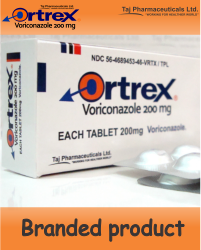FULL PRESCRIBING INFORMATION - DRUG INTERACTIONS

Ortrex Details
Contact Us
Taj Pharma India Brands
Taj Pharma Group (India)
214, Bake House, Bake House Lane,
Fort, Mumbai 400001, India.
E-mail: ortrex@tajpharma.com





DRUG INTERACTIONS
|
Effect of Other Drugs on Voriconazole Pharmacokinetics |
||
|
* Results based on in vivo clinical studies generally following repeat oral dosing with 200 mg q12h voriconazole to healthy subjects † Results based on in vivo clinical study following repeat oral dosing with 400 mg q12h for 1 day, then 200 mg q12h for at least 2 days voriconazole to healthy subjects ‡ Non-Nucleoside Reverse Transcriptase Inhibitors |
||
|
Drug/Drug Class (Mechanism of Interaction by the Drug) |
Voriconazole Plasma Exposure (Cmax and AUCτafter 200 mg q12h) |
Recommendations for Voriconazole Dosage Adjustment/Comments |
|
Rifampin* and Rifabutin* (CYP450 Induction) |
Significantly Reduced |
Contraindicated |
|
Efavirenz† (CYP450 Induction) |
Significantly Reduced |
When voriconazole is coadministered with efavirenz, voriconazole maintenance dose should be increased to 400 mg q12h and efavirenz should be decreased to 300 mg q24h |
|
High dose Ritonavir (400 mg q12h)† (CYP450 Induction) |
Significantly Reduced |
Contraindicated |
|
Low dose Ritonavir (100 mg q12h)† (CYP450 Induction) |
Reduced |
Coadministration of voriconazole and low dose ritonavir (100 mg q12h) should be avoided, unless an assessment of the benefit/risk to the patient justifies the use of voriconazole |
|
Carbamazepine (CYP450 Induction) |
Not Studied In Vivo or In Vitro, but Likely to Result in Significant Reduction |
Contraindicated |
|
Long-acting Barbiturates (CYP450 Induction) |
Not Studied In Vivo or In Vitro, but Likely to Result in Significant Reduction |
Contraindicated |
|
Phenytoin* (CYP450 Induction) |
Significantly Reduced |
Increase voriconazole maintenance dose from 4 mg/kg to 5 mg/kg IV q12h or from 200 mg to 400 mg orally q12h (100 mg to 200 mg orally q12h in patients weighing less than 40 kg) |
|
St. John’s Wort (CYP450 inducer; P-gp inducer) |
Significantly Reduced |
Contraindicated |
|
Oral Contraceptives† containing ethinyl estradiol and norethindrone (CYP2C19 Inhibition) |
Increased |
Monitoring for adverse events and toxicity related to voriconazole is recommended when coadministered with oral contraceptives |
|
Fluconazole† CYP2C9, CYP2C19 and CYP3A4 Inhibition) |
Significantly Increased |
Avoid concomitant administration of voriconazole and fluconazole. Monitoring for adverse events and toxicity related to voriconazole is started within 24 h after the last dose of fluconazole. |
|
Other HIV Protease Inhibitors (CYP3A4 Inhibition) |
In Vivo Studies Showed No Significant Effects of Indinavir on Voriconazole Exposure |
No dosage adjustment in the voriconazole dosage needed when coadministered with indinavir |
|
In Vitro Studies Demonstrated Potential for Inhibition of Voriconazole Metabolism (Increased Plasma Exposure) |
Frequent monitoring for adverse events and toxicity related to voriconazole when coadministered with other HIV protease inhibitors |
|
|
Other NNRTIs‡ (CYP3A4 Inhibition or CYP450 Induction) |
In Vitro Studies Demonstrated Potential for Inhibition of Voriconazole Metabolism by Delavirdine and Other NNRTIs (Increased Plasma Exposure) |
Frequent monitoring for adverse events and toxicity related to voriconazole |
|
A Voriconazole-Efavirenz Drug Interaction Study Demonstrated the Potential for the Metabolism of Voriconazole to be Induced by Efavirenz and Other NNRTIs (Decreased Plasma Exposure) |
Careful assessment of voriconazole effectiveness |
|
|
Effect of Voriconazole on Pharmacokinetics of Other Drugs |
||
|
* Results based on in vivo clinical studies generally following repeat oral dosing with 200 mg BID voriconazole to healthy subjects † Results based on in vivo clinical study following repeat oral dosing with 400 mg q12h for 1 day, then 200 mg q12h for at least 2 days voriconazole to healthy subjects ‡ Results based on in vivo clinical study following repeat oral dosing with 400 mg q12h for 1 day, then 200 mg q12h for 4 days voriconazole to subjects receiving a methadone maintenance dose (30 mg to 100 mg QD) § Non-Steroidal Anti-Inflammatory Drug ¶ Non-Nucleoside Reverse Transcriptase Inhibitors |
||
|
Drug/Drug Class (Mechanism of Interaction by Voriconazole) |
Drug Plasma Exposure (Cmax and AUC |
Recommendations for Dosage Adjustment/Comments |
|
Sirolimus* (CYP3A4 Inhibition) |
Significantly Increased |
Contraindicated |
|
Rifabutin* (CYP3A4 Inhibition) |
Significantly Increased |
Contraindicated |
|
Efavirenz† (CYP3A4 Inhibition) |
Significantly Increased |
When voriconazole is coadministered with efavirenz, voriconazole oral maintenance dose should be increased to 400 mg q12h and efavirenz should be decreased to 300 mg q24h |
|
High dose Ritonavir (400 mg q12h)† (CYP3A4 Inhibition) Low dose Ritonavir (100mg q12h)† |
No Significant Effect of Voriconazole on Ritonavir Cmax or AUCτ Slight Decrease in Ritonavir Cmax and AUCτ |
Contraindicated because of significant reduction of voriconazole Cmax and AUCτ Coadministration of voriconazole and low dose ritonavir (100 mg q12h) should be avoided (due to the reduction in voriconazole Cmax and AUCτ) unless an assessment of the benefit/risk to the patient justifies the use of voriconazole |
|
Terfenadine, Astemizole, Cisapride, Pimozide, Quinidine CYP3A4 Inhibition) |
Not Studied In Vivo or In Vitro, but Drug Plasma Exposure Likely to be Increased |
Contraindicatedbecause of potential for QT prolongation and rare occurrence of Torsades de pointes |
|
Ergot Alkaloids (CYP450 Inhibition) |
Not Studied In Vivo or In Vitro, but Drug Plasma Exposure Likely to be Increased |
Contraindicated |
|
Cyclosporine* (CYP3A4 Inhibition) |
AUCτ Significantly Increased; No Significant Effect on Cmax |
When initiating therapy with voriconazole in patients already receiving cyclosporine, reduce the cyclosporine dose to one-half of the starting dose and follow with frequent monitoring of cyclosporine blood levels. Increased cyclosporine levels have been associated with nephrotoxicity. When voriconazole is discontinued, cyclosporine concentrations must be frequently monitored and the dose increased as necessary. |
|
Methadone‡ (CYP3A4 Inhibition) |
Increased |
Increased plasma concentrations of methadone have been associated with toxicity including QT prolongation. Frequent monitoring for adverse events and toxicity related to methadone is recommended during coadministration. Dose reduction of methadone may be needed. |
|
Fentanyl (CYP3A4 Inhibition) |
Increased |
Reduction in the dose of fentanyl and other long-acting opiates metabolized by CYP3A4 should be considered when coadministered with voriconazole. Extended and frequent monitoring for opiate-associated adverse events may be necessary. |
|
Alfentanil (CYP3A4 Inhibition) |
Significantly Increased |
Reduction in the dose of alfentanil and other opiates metabolized by CYP3A4 (e.g., sufentanil) should be considered when coadministered with voriconazole. A longer period for monitoring respiratory and other opiate-associated adverse events may be necessary |
|
Oxycodone (CYP3A4 Inhibition) |
Significantly Increased |
Reduction in the dose of oxycodone and other long-acting opiates metabolized by CYP3A4 should be considered when coadministered with voriconazole. Extended and frequent monitoring for opiate-associated adverse events may be necessary |
|
NSAIDs§ including: ibuprofen and diclofenac (CYP2C9 Inhibition) |
Increased |
Frequent monitoring for adverse events and toxicity related to NSAIDs. Dose reduction of NSAIDs may be needed |
|
Tacrolimus* (CYP3A4 Inhibition) |
Significantly Increased |
When initiating therapy with voriconazole in patients already receiving tacrolimus, reduce the tacrolimus dose to one-third of the starting dose and follow with frequent monitoring of tacrolimus blood levels. Increased tacrolimus levels have been associated with nephrotoxicity. When voriconazole is discontinued, tacrolimus concentrations must be frequently monitored and the dose increased as necessary. |
|
Phenytoin* (CYP2C9 Inhibition) |
Significantly Increased |
Frequent monitoring of phenytoin plasma concentrations and frequent monitoring of adverse effects related to phenytoin. |
|
Oral Contraceptives containing ethinyl estradiol and norethindrone (CYP3A4 Inhibition)† |
Increased |
Monitoring for adverse events related to oral contraceptives is recommended during coadministration. |
|
Warfarin* (CYP2C9 Inhibition) |
Prothrombin Time Significantly Increased |
Monitor PT or other suitable anti-coagulation tests. Adjustment of warfarin dosage may be needed. |
|
Omeprazole* (CYP2C19/3A4 Inhibition) |
Significantly Increased |
When initiating therapy with voriconazole in patients already receiving omeprazole doses of 40 mg or greater, reduce the omeprazole dose by one-half. The metabolism of other proton pump inhibitors that are CYP2C19 substrates may also be inhibited by voriconazole and may result in increased plasma concentrations of other proton pump inhibitors. |
|
Other HIV Protease Inhibitors (CYP3A4 Inhibition) |
In Vivo Studies Showed No Significant Effects on Indinavir Exposure In Vitro Studies Demonstrated Potential for Voriconazole to Inhibit Metabolism (Increased Plasma Exposure) |
MNo dosage adjustment for indinavir when coadministered with voriconazole Frequent monitoring for adverse events and toxicity related to other HIV protease inhibitors |
|
Other NNRTIs¶ (CYP3A4 Inhibition) |
A Voriconazole-Efavirenz Drug Interaction Study Demonstrated the Potential for Voriconazole to Inhibit Metabolism of Other NNRTIs (Increased Plasma Exposure) |
Frequent monitoring for adverse events and toxicity related to NNRTI |
|
Benzodiazepines (CYP3A4 Inhibition) |
In Vitro Studies Demonstrated Potential for Voriconazole to Inhibit Metabolism (Increased Plasma Exposure) |
Frequent monitoring for adverse events and toxicity (i.e., prolonged sedation) related to benzodiazepines metabolized by CYP3A4 (e.g., midazolam, triazolam, alprazolam). Adjustment of benzodiazepine dosage may be needed. |
|
HMG-CoA Reductase Inhibitors (Statins) (CYP3A4 Inhibition) |
In Vitro Studies Demonstrated Potential for Voriconazole to Inhibit Metabolism (Increased Plasma Exposure) |
Frequent monitoring for adverse events and toxicity related to statins. Increased statin concentrations in plasma have been associated with rhabdomyolysis. Adjustment of the statin dosage may be needed. |
|
Dihydropyridine Calcium Channel Blockers (CYP3A4 Inhibition) |
A Voriconazole-Efavirenz Drug Interaction Study Demonstrated the Potential for Voriconazole to Inhibit Metabolism of Other NNRTIs (Increased Plasma Exposure) |
Frequent monitoring for adverse events and toxicity related to calcium channel blockers. Adjustment of calcium channel blocker dosage may be needed. |
|
Sulfonylurea Oral Hypoglycemics (CYP2C9 Inhibition) |
Not Studied In Vivo or In Vitro, but Drug Plasma Exposure Likely to be Increased |
Frequent monitoring of blood glucose and for signs and symptoms of hypoglycemia. Adjustment of oral hypoglycemic drug dosage may be needed. |
|
Vinca Alkaloids (CYP3A4 Inhibition) |
Not Studied In Vivo or In Vitro, but Drug Plasma Exposure Likely to be Increased |
Frequent monitoring for adverse events and toxicity (i.e., neurotoxicity) related to vinca alkaloids. Adjustment of vinca alkaloid dosage may be needed. |
Download Ortrex Overview
Ortrex® Voriconazole 200mg tablets are a prescription medicine used to treat certain serious fungal infections in your blood and body. Ortrex® Voriconazole 200mg tablets sold by Taj Pharmaceuticals Limited (India), a global pharmaceuticals company. It is available in India, Middle East and a few other South Asian countries.
![]() Ortrex® Voriconazole 200mg tablets_CMI
Ortrex® Voriconazole 200mg tablets_CMI
![]() Ortrex® Voriconazole 200mg tablets_FPI
Ortrex® Voriconazole 200mg tablets_FPI


 Home
Home